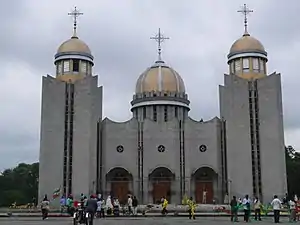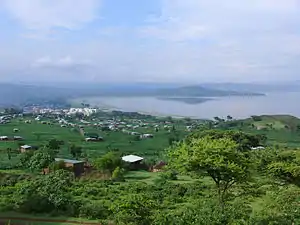Awasa
Awasa (Amharic: አዋሳ ʾäwasa, also spelled Awassa or Hawassa) is a city in Ethiopia, on the shores of Lake Awasa in the Great Rift Valley. It is 273 km (170 mi) south of Addis Ababa via Bishoftu, 130 km (81 mi) east of Sodo, and 75 km (47 mi) north of Dilla. The town serves as the capital of the Sidama Region and the Southern Nations, Nationalities, and Peoples' Region. It lies on the Trans-African Highway 4 Cairo-Cape Town and has a latitude and longitude of 7°3′N 38°28′E and an elevation of 1,708 meters (5,604 ft) above sea level. Its name comes from a Sidamic word meaning "wide body of water".
Hawassa (Awassa, Awasa)
አዋሳ (in Amharic) Hawassa | |
|---|---|
City | |
 Sidamo Monument at the City Center of Hawassa | |
 Hawassa (Awassa, Awasa) Location within Ethiopia | |
| Coordinates: 7°3′N 38°28′E | |
| Country | Ethiopia |
| Region | Sidama |
| Government | |
| • Mayor | Desta Daniel Wobbisa |
| Area | |
| • City | 50 km2 (20 sq mi) |
| Elevation | 1,708 m (5,604 ft) |
| Population (2016 est 1500000) | |
| • City | 315,267 |
| • Density | 6,300/km2 (16,000/sq mi) |
| • Urban | 320,000 |
| Time zone | UTC+3 (EAT) |
| Area code(s) | 46 |
| Climate | Aw |



The city is home to Hawassa University (which includes Wondo Genet College of Forestry and Natural Resources, an Agricultural College, the Main Campus, and a Health Sciences College), Awasa Adventist College, and a major market. The city is served by Awasa Airport (ICAO code HALA, IATA AWA), opened in 1988. Postal service is provided by the main branch; electricity and telephone service are also available.[1] Important local attractions include the St. Gabriel Church and the Awassa Kenema Stadium. Fishing is a major local industry.
Awasa was capital of the former Sidamo Province from about 1978 until the province was abolished with the adoption of the 1995 Constitution. It then became the capital of the Southern Southern Nations, Nationalities, and Peoples' Region. When the Sidama Region was formed in June 2020, the city became part of that region. Awasa currently serves as the capital of both the Sidama Region and the Southern Nations, Nationalities, and Peoples' Region. Awasa will continue to serve as the seat of government of the Southern Nations, Nationalities, and Peoples' Region for two national electoral cycles, after which the regional government will move to a city within the region's boundaries. [2]
History
In September 1994 alone, 194 members of the Sidama Liberation Movement (commonly known as SLM1 to distinguish it from the pro-government SLM2) were arrested and held in Awasa prison. The chairman of SLM1, Woldeamanuel Dubale, had fled to the United Kingdom after an unsuccessful attempt in 1992 to assassinate him.[3]
The Addis Tribune reported 31 May 2002 that government security forces in Awasa on Friday, 24 March, killed 38 farmers who were attempting to demonstrate against the government decided to move the capital of the Sidama Zone from Awasa and make it a chartered city, similar to Dire Dawa. Three thousand demonstrators of the Sidama people, the ethnic group that so far had control of the regional capital, had taken to the streets when police declared their demonstration illegal and opened fire. The regional government recently announced their decision to move the administrative center to Aleta Wendo.[3] Human Rights Watch had documented the deaths of 25 protesters, 12 of whom were children, and identified 26 more injured. These deaths came shortly after police shootings in Shambu, Ambo, and other towns in Oromia, resulting in five acknowledged student deaths. Rapid deployment forces of the federal and regional police also killed two at a meeting in Seraro the previous year.[4]
Population
Demographics
Based on the 2007 Census conducted by the Central Statistical Agency of Ethiopia, this zone has a total population of 258,808, of whom 133,123 are men and 125,685 women. While 157,879 or 61% are living in the city of Awassa, the rest of the population of this zone is living in surrounding rural kebeles. A total of 61,279 households were counted in this zone, which results in an average of 4.22 persons to a household, and 57,469 housing units.
The five largest ethnic groups reported in Awasa were the Amhara (17.43%), the Sidama (48.67%), the Welayta (13.9%), the Oromo (5.21%), and the Gurage (2.33%); all other ethnic groups made up 12.46% of the population. Amharic is spoken as a first language by 47.97% of the inhabitants, 21.01% speak Sidamo, 9.58% speak Welayta, and 2.07% Oromiffa; the remaining 9.37% spoke all other primary languages reported. The 1994 census reported this town had a total population of 69,169 of whom 35,029 were men and 34,140 were women.

Economy
Awassa Industrial Park (HIP) is situated on the outskirts of the city flanked by the picturesque Rift Valley Lake Awassa. The park that got 18 leading global apparel and textile companies by the end of 2017 was inaugurated by Prime Minister Hailemariam Desalegn on 20 June 2017. Construction of the park is led by Industrial Parks Development Corporation (IPDC), which is chaired by Arkebe Oqubay. The park is the first in its kind in the country, consumed more than US$250 million and was built in a time of less than one year. The zone implements Zero Liquid Discharge (ZLD) that enables to recycle 90 percent of sewerage disposal water and fulfills international standards. Covering an area of 1,300,000 m2 (14,000,000 sq ft), of which 300,000 m2 (3,200,000 sq ft) is factory shed build-up area, the park have additional area allocated for shared facilities.

As of 2020, about 30,000 people work there, and it's growing rapidly, albeit somewhat slower than expected.[5]
Religion
59.71% of the population said they were Protestants, 26.99% practiced Ethiopian Orthodox Christianity, 8.14% were Muslim and 3.78% embraced Catholicism.[6] The Latin Catholic minority is pastorally served by the missionary Apostolic Vicariate of Awasa, which has its Cathedral of Kidane-Meheret here.
Sport
Football (soccer) and swimming are the most played games in Awassa. Hawassa City S.C. (Amharic: አዋሳ ከተማ), a football club based in Hawassa—like Debub Police S.C. and Sidama Coffee S.C.—and using the Awassa Kenema Stadium, was the first to win the Ethiopian Premier League from outside of Addis Ababa, the capital. In addition to winning the league twice, the club took part twice in CAF Champions League. Other sports like basketball—represented by Hawassa City BC—and skateboarding are becoming popular among the youth. Biking and running competitions are occasionally held on the main streets of the town.
Education
Hawassa University, established in 1999 through the merger of a number of higher education institutions, is based in the city. Info link College is the first private engineering college found in Awassa City. Africa Beza College campus is also in the city. Hawassa University is the first university in Ethiopia to offer a Hotel Management degree program.
Climate
Awassa has a tropical savanna climate (Köppen Aw) though it borders on a subtropical highland climate (Köppen Cwb). There are two seasons: a lengthy though not intense wet season from March to October and a short dry season from November to February. The extra cloudiness of the wet season is sufficient to make it substantially cooler than the dry season despite a higher sun angle; however, the coolest morning temperatures, often close to freezing, occur during the dry season.
| Climate data for Awasa (1981–2010) | |||||||||||||
|---|---|---|---|---|---|---|---|---|---|---|---|---|---|
| Month | Jan | Feb | Mar | Apr | May | Jun | Jul | Aug | Sep | Oct | Nov | Dec | Year |
| Record high °C (°F) | 32 (90) |
33 (91) |
33 (91) |
33 (91) |
31 (88) |
30 (86) |
28 (82) |
29 (84) |
29 (84) |
30 (86) |
31 (88) |
31 (88) |
33 (91) |
| Average high °C (°F) | 29 (84) |
30 (86) |
30 (86) |
28 (82) |
27 (81) |
26 (79) |
24 (75) |
25 (77) |
25 (77) |
27 (81) |
28 (82) |
28 (82) |
27 (81) |
| Average low °C (°F) | 11 (52) |
12 (54) |
13 (55) |
14 (57) |
14 (57) |
14 (57) |
14 (57) |
14 (57) |
13 (55) |
12 (54) |
10 (50) |
10 (50) |
13 (55) |
| Record low °C (°F) | 0 (32) |
3 (37) |
5 (41) |
6 (43) |
9 (48) |
8 (46) |
7 (45) |
7 (45) |
7 (45) |
3 (37) |
0 (32) |
−2 (28) |
−2 (28) |
| Average rainfall mm (inches) | 29 (1.1) |
44 (1.7) |
100 (3.9) |
147 (5.8) |
133 (5.2) |
99 (3.9) |
128 (5.0) |
125 (4.9) |
140 (5.5) |
92 (3.6) |
30 (1.2) |
24 (0.9) |
1,091 (42.7) |
| Average rainy days (≥ 0.1 mm) | 5 | 8 | 16 | 16 | 16 | 15 | 19 | 20 | 22 | 14 | 5 | 4 | 160 |
| Source 1: World Meteorological Organization[7] | |||||||||||||
| Source 2: National Meteorology Agency (records)[8] | |||||||||||||
Notes
- "Detailed statistics on infrastructure" Archived 2011-07-20 at the Wayback Machine, Southern Nations, Nationalities and People's Region, Bureau of Finance and Economic Development website (accessed 27 September 2009)
- http://addisstandard.com/news-snnprs-council-approves-legal-framework-which-makes-hawassa-city-accountable-to-future-sidama-regional-state/
- "Local History in Ethiopia" Archived 2008-02-28 at the Wayback Machine (pdf) The Nordic Africa Institute website (accessed 18 December 2007)
- "Ethiopia: Police Firing on Unarmed Protesters", Human Rights Watch website, published 10 June 2006 (accessed 7 July 2009)
- The Economist, March 28th 2020, "The African century", page 10.
- Census 2007 Tables: Southern Peoples, Nations and Nationalities Region Archived November 13, 2012, at the Wayback Machine, Tables 2.1, 2.4, 2.5, 3.1, 3.2 and 3.4.
- "World Weather Information Service – Awasa". World Meteorological Organization. Retrieved 27 July 2016.
- "Climate of City: Hawassa". National Meteorological Agency. Retrieved 27 July 2016.
External links
| Wikivoyage has a travel guide for Awasa. |
| Wikimedia Commons has media related to Awasa. |

